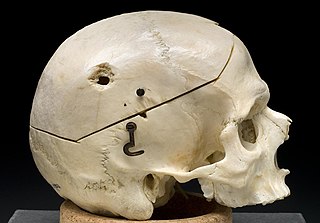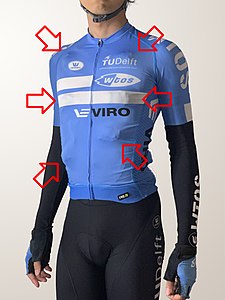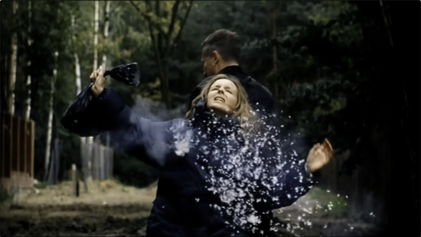
Hydrostatic shock is the controversial concept that a penetrating projectile can produce a pressure wave that causes "remote neural damage", "subtle damage in neural tissues" and "rapid incapacitating effects" in living targets. It has also been suggested that pressure wave effects can cause indirect bone fractures at a distance from the projectile path, although it was later demonstrated that indirect bone fractures are caused by temporary cavity effects.

A cartridge, also known as a round, is a type of pre-assembled firearm ammunition packaging a projectile, a propellant substance and an ignition device (primer) within a metallic, paper, or plastic case that is precisely made to fit within the barrel chamber of a breechloading gun, for convenient transportation and handling during shooting. Although in popular usage the term "bullet" is often used to refer to a complete cartridge, the correct usage only refers to the projectile.

Terminal ballistics is a sub-field of ballistics concerned with the behavior and effects of a projectile when it hits and transfers its energy to a target.

Pyrotechnics is the science and craft of creating such things as fireworks, safety matches, oxygen candles, explosive bolts and other fasteners, parts of automotive airbags, as well as gas-pressure blasting in mining, quarrying, and demolition. This trade relies upon self-contained and self-sustained exothermic chemical reactions to make heat, light, gas, smoke and/or sound. The name comes from the Greek words pyr ("fire") and tekhnikos.

Expanding bullets, also known colloquially as dumdum bullets, are projectiles designed to expand on impact. This causes the bullet to increase in diameter, to combat over-penetration and produce a larger wound, thus dealing more damage to a living target. For this reason, they are used for hunting and by most police departments, but are generally prohibited for use in war. Two typical designs are the hollow-point bullet and the soft-point bullet.

A practical effect is a special effect produced physically, without computer-generated imagery or other post-production techniques. In some contexts, "special effect" is used as a synonym of "practical effect", in contrast to "visual effects" which are created in post-production through photographic manipulation or computer generation.

Ballistic gelatin is a testing medium designed to simulate the effects of bullet wounds in animal muscle tissue. It was developed and improved by Martin Fackler and others in the field of wound ballistics. It is calibrated to match pig muscle, which is ballistically similar to human muscle tissue.

A blank is a firearm cartridge that, when fired, does not shoot a projectile like a bullet or pellet, but generates a muzzle flash and an explosive sound like a normal gunshot would. Firearms may need to be modified to allow a blank to cycle the action, and the shooter experiences less recoil with a blank than with a live round. Blanks are often used in prop guns for shooting simulations that have no need for ballistic results, but still demand light and sound effects, such as in historical reenactments, special effects for theatre, movie and television productions, combat training, for signaling, and cowboy mounted shooting. Specialised blank cartridges are also used for their propellant force in fields as varied as construction, shooting sports, and fishing and general recreation.

A squib is a miniature explosive device used in a wide range of industries, from special effects to military applications. It resembles a tiny stick of dynamite, both in appearance and construction, but has considerably less explosive power. A squib consists of two electrical leads separated by a plug of insulating material; a small bridge wire or electrical resistance heater; and a bead of heat-sensitive chemical composition, in which the bridge wire is embedded. They can be used to generate mechanical force to shatter or propel various materials; and for pyrotechnic effects for film and live theatrics.

A flak jacket or flak vest is a form of body armor. A flak jacket is designed to provide protection from case fragments ("frag") from high explosive weaponry, such as anti-aircraft artillery, grenade fragments, some types of pellets used in shotguns, and other lower-velocity projectiles. It is not designed to protect against bullets fired from most small arms such as rifles or handguns. However flak jackets are able to sustain certain gunshots, depending on the angle at which the shot was fired, the caliber of the bullet, the speed of the projectile and the range from which the shot was fired.
Stopping power is the ability of a weapon – typically a ranged weapon such as a firearm – to cause a target to be incapacitated or immobilized. Stopping power contrasts with lethality in that it pertains only to a weapon's ability to make the target cease action, regardless of whether or not death ultimately occurs. Which ammunition cartridges have the greatest stopping power is a much-debated topic.
Handgun effectiveness is a measure of the stopping power of a handgun: its ability to incapacitate a hostile target as quickly and efficiently as possible.

A gunshot wound (GSW) is a penetrating injury caused by a projectile from a gun. Damages may include bleeding, bone fractures, organ damage, wound infection, loss of the ability to move part of the body, and in severe cases, death. Damage depends on the part of the body hit, the path the bullet follows through the body, and the type and speed of the bullet. Long-term complications can include bowel obstruction, failure to thrive, neurogenic bladder and paralysis, recurrent cardiorespiratory distress and pneumothorax, hypoxic brain injury leading to early dementia, amputations, chronic pain and pain with light touch (hyperalgesia), deep venous thrombosis with pulmonary embolus, limb swelling and debility, and lead poisoning.
The following are terms related to firearms and ammunition topics.

Theatrical blood, stage blood or fake blood is anything used as a substitute for blood in a theatrical or cinematic performance. For example, in the special effects industry, when a director needs to simulate an actor being shot or cut, a wide variety of chemicals and natural products can be used. The most common is red food coloring, often inside small balloons coupled with explosive devices called squibs.

Bodily mutilation in film refers to practical effects implemented on a film set during production, in contrast to special effects, which are applied in post-production. The primary objective is to visually depict physical trauma endured by a character, aiming to elicit emotional responses from the audience and foster empathy towards the character. Bodily mutilation is most usually portrayed in the context of horror, but is also used in other genres, such as medical dramas or war films. It is used primarily either to shock or fascinate the audience of a film, or to add a sense of realism. Improved special effects in recent decades have seen an increase in the prevalence of bodily mutilation in film.
Blood squirt is the effect when an artery is ruptured. Blood pressure causes the blood to bleed out at a rapid, intermittent rate in a spray or jet, coinciding with the pulse, rather than the slower, but steady flow of venous bleeding. Also known as arterial bleeding, arterial spurting, or arterial gushing, the amount of blood loss can be copious, occur very rapidly, and can lead to death by a process called exsanguination.
"Bullet Points" is the fourth episode of the fourth season of the American television drama series Breaking Bad, and the 37th overall episode of the series. It originally aired on AMC in the United States on August 7, 2011.
An abrasion collar, also known as an abrasion ring or abrasion rim, is a narrow ring of stretched, abraded skin immediately surrounding projectile wounds, such as gunshot wounds. It is most commonly associated with entrance wounds and is a mechanical defect due to a projectile's penetration through the skin. It is caused by a temporary over-stretching of the skin surrounding the projectile's point of penetration. Like all skin abrasions, the abrasion collar tends to dry out due to scraping away of the skin's outer layers and the collapse and dehydration of the underlying cells; it therefore becomes easier to discern with time. This defect is most often seen around rifled firearm entrance wounds due to the striations or grooves in the bullet's surface caused by the rifling on the inside of the weapon's barrel; however, certain other high-velocity projectile wounds can also have the same effect.

Stage clothes worn by actors who portray characters that are shot and wounded in movies, TV shows, or theatre productions are modified to conceal special effects equipment such as squibs, wires and controllers are commonly referred to as "dead-character costumes". These costumes are a crucial element to create a captivating and dramatic scene. Typically, several identical sets of these costumes are prepared for the planned number of takes as "consumables" and are used only once. After use, they are placed on the "dead-character rack" and not reused, unlike other clothing articles that return to the costume shop.





























